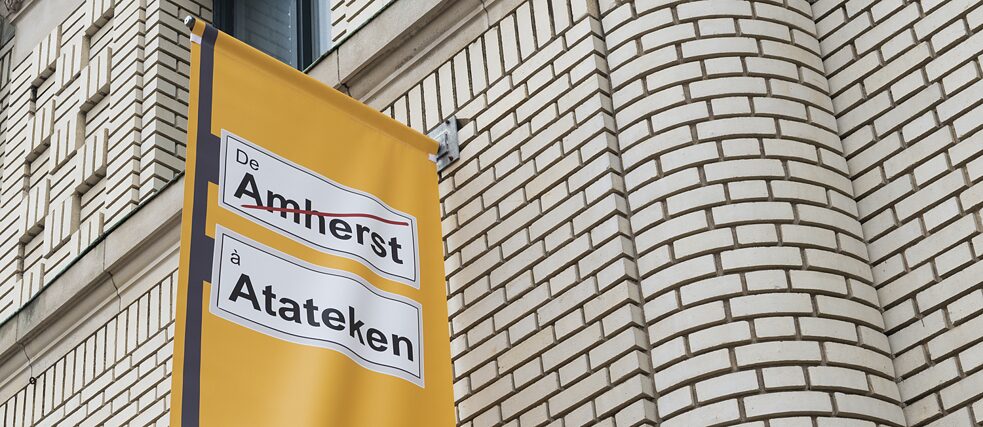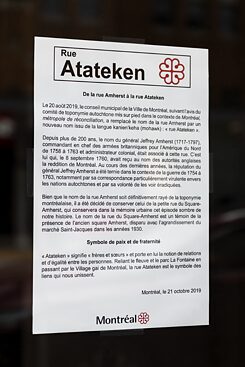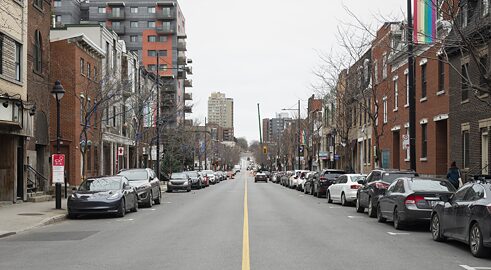Je me souviens
Renaming The Past

The names of streets, squares and other places reveal a lot about how a city and its leaders want their history to be remembered. As perspectives on the city’s heritage change and become more diverse, the bureaucratic and contextual challenges of correcting the errors of the past become apparent.
By Christopher Curtis
It helps to think of the Mohawk language as a living thing.
Because it comes from an oral tradition, it isn’t easily constrained to letters on a page. A single word can thread together a person, an action and a place. Something as simple as Kenien:kéha — “language of the flint people” — is three distinct elements merging to form a word. So if something so lively is difficult to put to paper, you can imagine it’s even harder to put on a street sign.
Homage to Montreal’s Indigenous roots
This was perhaps one of the largest hurdles that Akwiratékha Martin and Hilda Nicholas had to overcome as they tried, in 2018, to come up with a name that would replace the infamous Amherst St. in downtown Montreal.“They wanted us to call it three sisters (the name Mohawks give to the staple crops of corn, beans and squash) but that was too long,” said Martin, a Mohawk language teacher in the Kahnawake territory, south of Montreal.
“I said, ‘No, it’s gonna bust the sign and go around the block it’s so long.’ Áhsen nikontate’kèn:‘a. Imagine saying that to a cab driver?”
They laboured on, working with the city’s Reconciliation Commissioner so that the street named after a problematic British general could finally turn into something that pays homage to Montreal’s Indigenous roots.
When it comes to street names, Montrealers haven’t always embraced change.
Mayor Jean Doré’s 1987 decision to rename Dorchester Blvd. after the recently deceased René Levesque — one of the men who shaped modern Quebec — sparked a backlash from the city’s anglophone minority. “Doré has created a silly language crisis for no real reason,” said city councillor Nick Auf der Maur, noting that Dorchester, a British governor of New France, spoke to Montreal’s bilingual heritage. But the name changed. René Levesque Blvd. now spans from the east side of Jacques Cartier Bridge through downtown and all the way to the city of Westmount where it’s still called Dorchester.
When Mayor Gerald Tremblay tried to rename Parc Ave. in honour of former Liberal Premier Robert Bourassa in 2006, the blowback from merchants and residents forced him to abandon the idea altogether.
It took another eight years, three mayors and one typically Montreal compromise for Bourassa’s name to finally adorn a downtown street sign. Mayor Denis Coderre had to split a street in half to get in done. The lower section bears Bourassa’s name while the section that skirts McGill University kept its old moniker: University St.
Part of a much broader movement
There was no such controversy when Coderre’s administration launched the process to rename Amherst St. in 2017.Two years prior, Justin Trudeau’s Liberals had won a sweeping majority in the federal election, promising to rebuild Canada’s relationship with First Nations. The new government launched a public inquiry into the prevalence of missing and murdered Indigenous women in Canada and Quebec was conducting its own parliamentary investigation into anti-Indigenous racism in government institutions. So when Indigenous groups raised the issue of renaming the downtown street, it was part of a much broader movement.
“General Jeffery Amherst became a symbol of colonialism,” said Elizabeth Elbourne, who teaches English history at McGill. “He had strong anti-Indigenous views. He famously gave smallpox-infected blankets to an Indigenous camp during Pontiac’s war. Once that becomes the symbol of Amherst, you can’t justify keeping the name.”
“You can’t have reconciliation and General Amherst”
It was Cree lawyer Marie-Eve Bordeleau who was given the task of overseeing the name change. The mayor appointed Bordeleau to be Montreal’s reconciliation commissioner, the person to ensure the city would be a place that fosters better relations between settlers and Indigenous people.“You can’t have reconciliation and General Amherst, those two just don’t go together,” said Bordeleau. “But what do you put in his place? There was never really a question that a new name would have to be in the Mohawk language. Montreal is on unceded Iroquois territory and it seemed only right that the new name would be in Mohawk. So we put together a team of Indigenous people from across Quebec but the actual phrasing of the new name had to come from Mohawk language speakers.
“That might have been the easiest part of the process because renaming a street, as it turns out, is a hell of an undertaking.”
Montreal doesn’t technically have jurisdiction over naming its own streets. That decision has to approved by a provincial committee, which evaluates things like the length of the street name, whether it corresponds to Quebec’s language laws and a series of other “very strict” criteria, according to Bordeleau.
“The name can’t be too long or complicated for safety reasons. If someone calls the police, for instance, they have to be able to say it quickly,” she said. During one of the naming committee meetings in 2018, Martin and Nicholas broke off and began speaking to each other in the Mohawk language. “There’s a phrase we use, ‘all my relations’ — tewatatè:ken — it’s like saying ‘we’re brothers and sisters together.’ We shortened it so that there’s no pronoun, that it’s not men or women: Atateken. It sounded good.”
The new name was unveiled on a sunny June morning in 2019, Indigenous Peoples Day to be exact. During a ceremony where leaders from the nearby Mohawk territories of Kahnawake and Kanesatake addressed the crowd, Chief Serge Simon said that Atateken St. signalled a “change of mindset,” that it shows us Montreal is grappling with a missing piece of its history.
Martin’s experience was slightly less profound.
“I drove by it a few months after they changed the signs and I had almost forgotten it was there,” he said. “I was touched. It was like, ‘I contributed a bit.’ Because of my elders there’s a part of us on that sign. It was an honour to be a part of that.”
Declaration of the city of Montreal
 Street sign at the rue Atateken
| © Monik Richter
From Amherst Street to Atateteken Street
Street sign at the rue Atateken
| © Monik Richter
From Amherst Street to Atateteken Street
On August 20, 2019, following the advice of the Aboriginal Toponymy Committee set up in the context of Montréal, a city of reconciliation, the City Council of Montreal replaced the name of the rue Amherst with a new name derived from the Kanien'keha (Mohawk) language: "Atateken ".
For more than 200 years, the name of General Jeffrey Amherst (1717-1797), commander-in-chief of the British armies for North America from 1758 to 1763 and colonial administrator, was associated with this street. It was he who, on September 8, 1760, received the surrender of Montreal on behalf of the English authorities. In recent years, General Jeffrey Amhrst's reputation has been tarnished in the context of the war of 1754-1763, particularly by his extraordinarily virulent correspondence with the Aboriginal nations and by his desire to see them eradicated.
Although the name of rue Amherst was definitively erased from Montreal's toponymy, it was decided to keep the name of the small street called rue Amherst-Square, which will keep this dark episode in our history in the city's memory. The name of rue Square-Amherst is a witness to the presence of the former Amherst Square, which disappeared with the expansion of the Saint-Jacques market in the 1930s.
Symbol of peace and fraternity
"Atateken" means "brothers and sisters" and carries within it the notion of relationships and equality between people. Linking the St-Lawrence stream and La Fontaine Park through the Gay Village of Montreal, Atateken Street is a symbol of the bonds that unite us.
Montréal, October 21, 2019


Comments
Comment